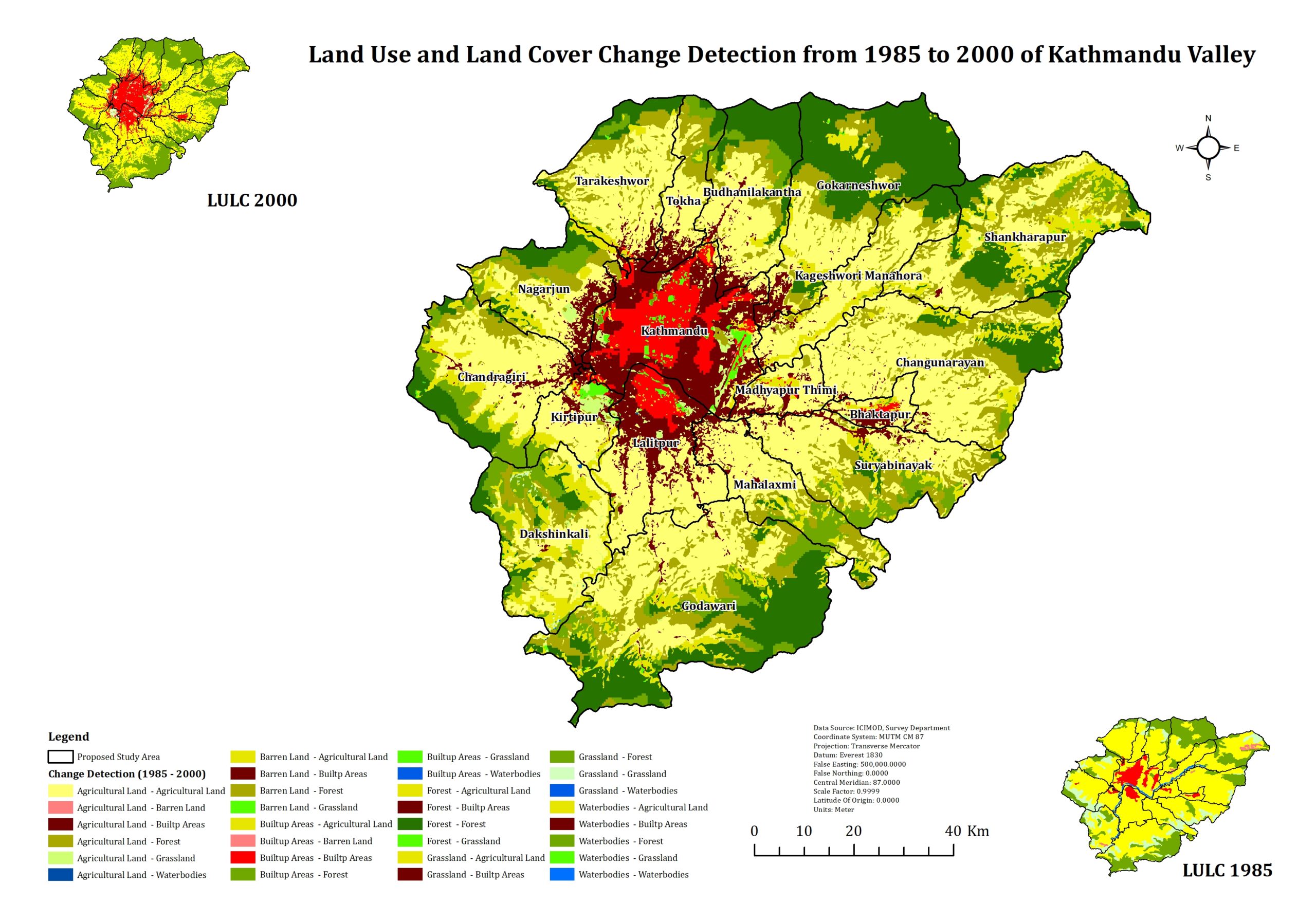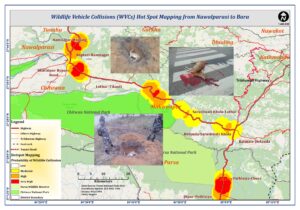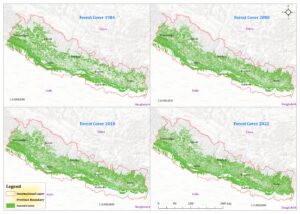Land Cover Change Detection of Kathmandu Valley: A 15-Year Perspective 1985-2000
The analysis of Land Cover Change Detection of Kathmandu Valley: A 15-Year Perspective 1985-2000 provides valuable insights into the transformation of various land categories during this period. The dataset includes different pairs of land cover classes, indicating transitions and alterations in land use patterns. The area in hectares associated with each change detection category sheds light on the extent of modifications that occurred over the 15-year period. The changes may have implications for food security, biodiversity, and the overall ecological balance in the region.
One notable observation is the substantial conversion of Agricultural Land to different land cover types. The largest transition in terms of area is from Agricultural Land to Agricultural Land itself, accounting for 27,436.17 hectares. This suggests that a significant portion of the agricultural landscape remained relatively stable over the years. However, Land Cover Change Detection of Kathmandu Valley: A 15-Year Perspective 1985-2000 is essential to delve into the finer details of the transitions to understand the dynamics. Agricultural Land transforming into Barren Land, with an area of 331.42 hectares, signifies a loss of fertile land resources. Similarly, transitions to Forest (3,193.79 hectares), Waterbodies (458.63 hectares), Grassland (2,163.13 hectares), and Builtup Areas (287.20 hectares) indicate diverse transformations within the agricultural sector.
Conversely, the transitions from Builtup Areas to other land cover types are also noteworthy. The conversion of Builtup Areas to Agricultural Land (5,712.00 hectares) and Forest (119.20 hectares) indicates urban expansion and encroachment into previously non-urban areas. Such changes raise concerns about the sustainability of urbanization and its impact on natural ecosystems. The transformation of Forest areas is another critical aspect of the analysis. While Forest to Forest transitions are predominant (11,140.43 hectares), Forest to Agricultural Land (10,520.91 hectares) highlights the pressures on forested regions due to agricultural activities. Forest areas also saw conversions to Barren Land, Waterbodies, Grassland, and Builtup Areas, emphasizing the multifaceted nature of land use changes within forested regions.
The changes in Grassland and Waterbodies are relatively smaller in comparison but still hold significance. Grassland conversions, especially to Builtup Areas (311.33 hectares), reflect the impact of urbanization on natural grassland ecosystems. Waterbodies, despite being relatively stable, experienced changes, with transitions to Agricultural Land, Grassland, and Builtup Areas, suggesting alterations in water resource management and land development.
In summary, the land use and land cover change detection analysis of Land Cover Change Detection of Kathmandu Valley: A 15-Year Perspective 1985-2000 reveals a complex interplay of transformations across different categories. The findings underscore the need for sustainable land management practices and policies to address the evolving dynamics of urbanization, agriculture, and conservation in the region.
In summary, the analysis of Land Cover Change Detection in Kathmandu Valley from 1985 to 2000 unravels a complex interplay of transformations across different categories. The findings emphasize the need for sustainable land management practices and policies to address the evolving dynamics of urbanization, agriculture, and conservation in the region.
As policymakers and stakeholders delve into these intricate patterns of change revealed by the data, Land Cover Change Detection of Kathmandu Valley: A 15-Year Perspective 1985-2000 becomes crucial for them to carefully consider the implications on food security, biodiversity conservation, and the overall ecological balance. This comprehensive understanding of land cover changes is essential for formulating effective strategies that strike a balance between urban development, agricultural activities, and the preservation of natural ecosystems in Kathmandu Valley.
Given these findings, Land Cover Change Detection of Kathmandu Valley: A 15-Year Perspective 1985-2000 is imperative to develop and implement policies that promote sustainable land use practices while considering the delicate equilibrium between human development and environmental preservation. By doing so, we can ensure a harmonious coexistence between urban growth and environmental protection in Kathmandu Valley for generations to come.




